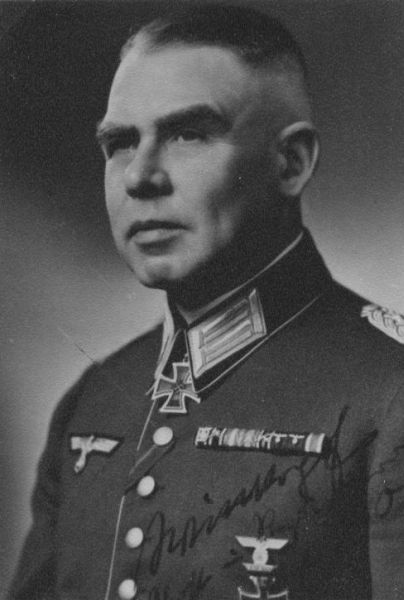Wittkopf, Heinrich
- Date of birth:
- August 15th, 1892 (Hildesheim/Hannover, Germany)
- Date of death:
- February 12th, 1946 (Oostend, Belgium)
- Buried on:
- German War Cemetery Lommel
Plot: 62. Grave: 197. - Nationality:
- German (1933-1945, Third Reich)
Biography
Heinrich Wittkopf finally reached the rank of Generalmajor as Kommmandant Greifswald, Pommerania. He died at Oostende, Belgium in British imprisonment on 12th February 1946.
Do you have more information about this person? Inform us!
- Period:
- Second World War (1939-1945)
- Rank:
- Oberst
- Unit:
- Grenadier-Regiment 530
- Awarded on:
- February 28th, 1943
- Period:
- Second World War (1939-1945)
- Rank:
- Oberst (Colonel)
- Unit:
- Kommandeur Infanterie-Regiment 530
- Awarded on:
- September 29th, 1941
“At the start of the Eastern Campaign the Regiment under the command of Oberst Wittkopf was deployed as flank security for an Armee. In additional to success in friendly mop-up operations it also achieved major feats of marching along relatively bad roads. At the end of June the main forces of the Armee ran into stronger resistance. The Regiment’s reconnaissance reported growing enemy concentrations in a large patch of forest, wherein tanks were also sighted. It was obvious that the enemy was planning a thrust into the deep flank of the Armee so as to cut off our foremost Panzer elements. Thus on the 30.06.1941 the Regiment set up a strongpoint-like defense along a broad front and awaited the enemy.
Oberst Wittkopf reported on the course of the battle in a letter to K.H. Waldow (in Heidelberg), which is reproduced as follows: ‘On the afternoon of the 01.07.1941 Soviet tank forces probed the positions of the Regiment, but were fought off. Then at 03:30 on the next day overwhelming attacks were launched by enemy motorized infantry, escorted by strong tank forces. These futile attacks were carried on until 14:00, when they finally subsided. The last reserves had already been deployed by this time. At 15:00 I gave the order for a counterattack, which was launched with great offensive spirit and resulted in a total victory. In addition to numerous assorted weapons and military equipment, 6 heavy guns and 34 tanks (including 3 tanks of the 52-ton type) were destroyed or captured.’ The Army Report reported on this same success in a shorter form: ‘Through his victory on the flank Oberst Wittkopf saved not only his Korps, but also the whole Armee, from an extremely trying situation.’
The Regiment would also distinguish itself in the following battles (most of which were quite tough) as the foremost unit in the attack and as the toughest in defense. As a result it was repeatedly praised with special mentions by the higher commands.
The German student body congratulates Oberst Wittkopf on the award of the Knight’s Cross to the Iron Cross and wishes him the best of soldierly luck for his future battles.”
- Period:
- Second World War (1939-1945)
- Period:
- Second World War (1939-1945)
- Period:
- First World War (1914-1918)
- Period:
- First World War (1914-1918)
- Period:
- First World War (1914-1918)
Sources
- Photo 1: Norbert Beyerlein
- Photo: Beyerlein sammlung
- - Die Ordensträger der Deutschen Wehrmacht (CD), VMD-Verlag GmbH, Osnabrück, 2002
- Fellgiebel W.P., Elite of the Third Reich, The recipients of the Knight's Cross of the Iron Cross 1939-1945: A Reference, Helion & Company Limited, Solihull, 2003, ISBN 1-874622-46-9
- Patzwall K., Scherzer V., Das Deutsche Kreuz 1941-1945, Geschichte und Inhaber Band II, Verlag Klaus D. Patzwall, Norderstedt, 2001, ISBN 3-931533-45-X
- Die Bewegung, 16.05.1942, pg. 16









